December 14, 2020 feature
Magnetically controlled, hydrogel-based smart transformers
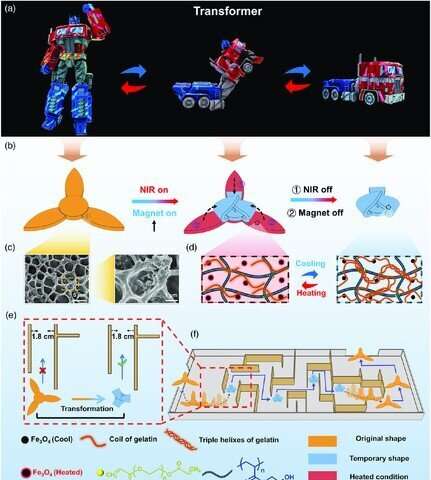
While the film "Transformers" introduced intelligent robots that morphed between shapes with multiple functionalities, researchers are developing intelligent soft transformers to significantly accelerate research applications in the lab. In a recent report now published in Advanced Intelligent Systems, Dachuan Zhang and a research team in materials science and chemical sciences in China, proposed a remotely controlled soft transformer based on a shape memory hydrogel system. The team obtained the hydrogel by embedding magnetite (Fe3O4) magnetic nanoparticles into a double network polymer structure of poly (N-(2-hydroxyethyl) acrylamide) containing gelatin.
The reversible coil-triple-helix transformation of the gelatin constituent imbued the hydrogel with shape memory and self-healing properties, while the magnetite nanoparticles gave photothermal heating and magnetic manipulation functions to deform the hydrogel for navigation in a magnetic field. The team could then restore the deformed shape via shape recovery using light irradiation. Zhang et al. remotely controlled the shape-memory processes through magnetically driven actuation and light-assisted shape memory. As proof of concept, they created a series of robots, including a hydrogel athlete that could do sit-ups, hydrogel transformers, a lotus in full bloom, and a hydrogel spacecraft that can be docked in air. The work will inspire the design and fabrication of new smart polymer systems with synchronized multiple functionalities.
Shape memory hydrogels
While the fictional transformers allowed hard robots to morph into any form including vehicles, soft transformers are of greater interest in fundamental research and applications in life sciences. In this work, Zhang et al. described a photothermally and magnetically controlled shape memory hydrogel. They combined a chemically crosslinked polymer and a reversibly crosslinked gelatin network embedded with magnetite nanoparticles to create a photothermal and flexible, self-healing construct that could be magnetically manipulated. Shape memory hydrogels (SMHs) have received increased attention as intelligent polymeric materials and researchers aim to remotely control such materials to establish diverse actuating behaviors.
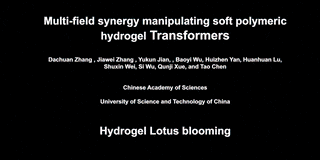
For example, shape-memory polymers can fix temporary shapes and recover their architecture under external stimuli, with increasing interest across biomedical, textile, flexible electronics and data encryption disciplines. Magnetic nanoparticles are effective additives to introduce remotely controlled non-contact actuation. When hydrogels are illuminated with near-infrared (NIR) light, these magnetic nanoparticles will continuously convert light into heat, causing the hydrogel to be heated. This will cause reversible deformation of the hydrogel for applications as freely moving soft robots. This strategy will help promote the development of new shape memory hydrogel systems for applications as untethered robots.
Properties of shape memory hydrogels
Since shape memory hydrogels can stably and temporarily memorize their shape and recover the original shape perfectly under specific stimuli, the team conducted bending tests with the material, which they abbreviated as HG for its constituent polymers. They then immersed a sample in hot water (60 degrees Celsius) for 30 seconds to induce disaggregation to soften the hydrogel, removed it from the medium and recovered the shapes after re-immersing hydrogels in hot water (60 degrees Celsius). Zhang et al. conducted a series of controlled experiments to verify the factors affecting the shape memory performance of the hydrogel. As proof of concept, the team designed and developed a hydrogel flower to perfectly mimic the bloom of a lotus.
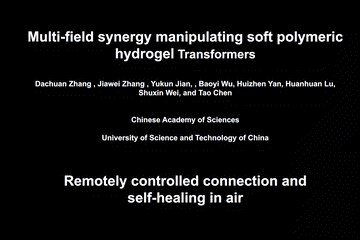
When the researchers introduced magnetite nanoparticles to form the HG-Fe3O4 hydrogel, the constituents could absorb and convert light to heat with light irradiation, causing the temperature of the hydrogel to increase. During light-to-heat conversion, the material achieved photo-activated self-healing. To demonstrate this phenomenon, the team created a HG-Fe3O4 hydrogel space station under a magnetic field and applied NIR to irradiate the connectors and dock the spacecraft-like construct with a space station-like connector to realize self-healing and reconnection in air.
Recovering shapes through photothermal effects and remotely controlling shape memory processes
The team could only achieve shape recovery for the HG-hydrogel by regulating the temperature to a specific value, in the absence of magnetite nanoparticles. The addition of magnetite conferred magnetic properties to the HG-Fe3O4 hydrogel to allow remotely controlled shape memory recovery cycles. As proof of concept, the team developed a shape-transition robot in the form of a hydrogel athlete to deform from 2-D to 3-D. In the absence of NIR and the presence of a magnet, the hydrogel athlete could 'push up' quickly, then recover its shape to the flat conformation on removal of the magnet. In the second setup, they turned-on NIR and lifted the hydrogel athlete with a magnet, then kept the magnet on for two minutes while switching off the NIR to allow the athlete to cool down. The team froze this gesture for a timeframe after which they allowed the robot to return to its original position by turning-on the NIR again. This technique can be used to develop soft grippers that are advantageous for applications as surgical robots in translational research.
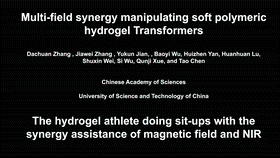
The team also used the interaction between permanent magnets and the constituent magnetite nanoparticles of the HG-Fe3O4 hydrogel to guide the construct for directional navigation. Using the hydrogel, they showed how magnet-induced directional navigation could guide a soft transformer through a maze. Such experimental concepts have potential for a range of applications as soft carriers to transport cargo for drug delivery and release in biomedicine.
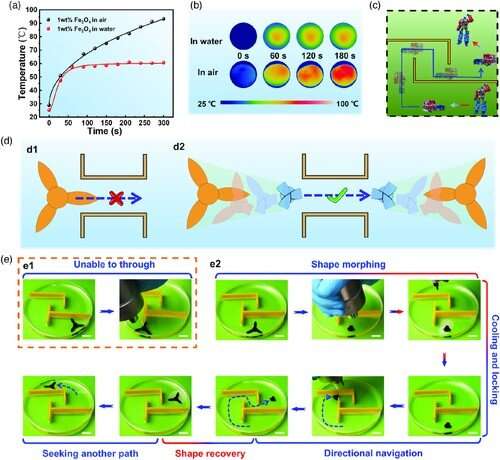
Outlook for soft transformers in life sciences
In this way, Dachuan Zhang and colleagues developed a new and effective method to build soft hydrogel transformers with magnetic and photothermal properties integrated into a shape memory hydrogel (SMH) system. The resulting HG-Fe3O4 hydrogels had highly advantageous properties including noncontact shape deformation, magnetic actuation, photothermal performance, self-healing and directional navigation in water and air. The team developed a series of proof-of-concept soft robots to demonstrate the dynamic properties of the SMH system and believe that this design concept will inspire the development of new intelligent systems for applications in bioengineering and biomedicine.
More information: Multi‐Field Synergy Manipulating Soft Polymeric Hydrogel Transformers, Advanced Intelligent Systems, doi.org/10.1002/aisy.202000208
Lendlein A. & Gould O.E.C. Reprogrammable recovery and actuation behaviour of shape-memory polymers, Nature Reviews Materials doi.org/10.1038/s41578-018-0078-8
Zhao C. et al. Layered nanocomposites by shear-flow-induced alignment of nanosheets, Nature, doi.org/10.1038/s41586-020-2161-8
Journal information: Nature
© 2020 Science X Network




















